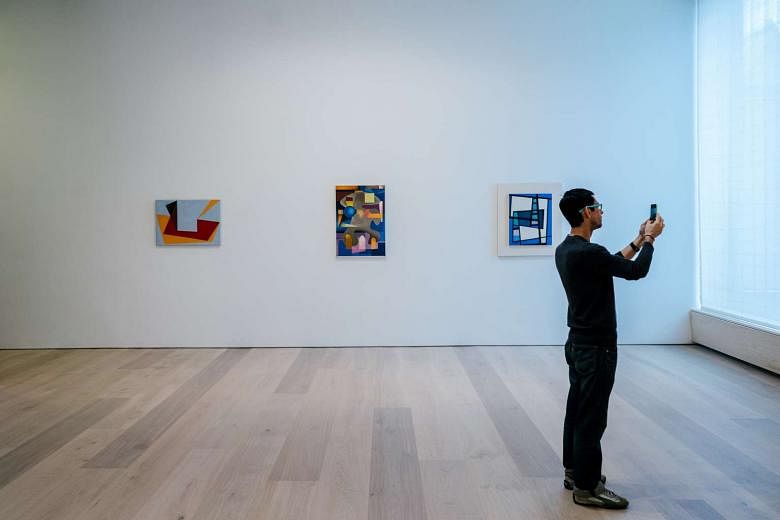NEW YORK • Standing in an art gallery in Manhattan, art market researcher-cum-entrepreneur Mag- nus Resch opened an app on his iPhone and beamed.
"Take a picture of an artwork," he said, handing over his phone, which displayed a salmon-red and white interface bearing the logo "Magnus".
A button on the screen was dutifully pressed and the artwork in question - a 1973 image by the photographer Hiro, which was presented without a label on the gallery's wall - appeared, after a beat, on the phone, correctly identified. But the app did not just display the artwork; it loaded, unprompted, the photo's title, attribution, dimension, price (US$20,000 or S$27,000), and, further down on the screen, a history of past work and exhibitions by the artist.
"It's the Shazam of the art world," Mr Resch said, still smiling.
The premise of Magnus, which was first reported by The New York Times, is simple, straightforward and ambitious. The app aims to catalogue the existence and price of every artwork and to make that information publicly available. It is the holy grail of the art market. Accordingly, Magnus is not the art world's first attempt. Artsy, Artnet and others have set out to do the same thing with (mostly) disappointing results, in large part because it is a Herculean task by any measure - artworks are made and sold every day, often without any public exposure. That is why a database like Artnet focuses exclusively on publicly available auction sales, and that is also why Mr Resch's app, which has logged about eight million artworks, could be a game changer.
Unlike Artnet, Mr Resch's database also includes works on the primary market - about 12 per cent of his total database. It is that 12 per cent sliver that makes Magnus so compelling.
"I'm providing true access to the art market," Mr Resch said later. "People who've thus far been left out of the market can become buyers: They see comparable prices. We're equipping non-experts with the knowledge of an expert."
In other words, his app is for people outside of the art world who walk into a gallery, see a photo on sale for US$20,000 and wonder (quite reasonably) why it costs US$20,000 and not US$5,000. If that same person can walk into a gallery and use Magnus to access the artist's exhibition history and price records, Mr Resch reasons, the photo's US$20,000 price might make more sense.
The biggest issue is the same that has boondoggled other past attempts: keeping the primary market database up to date. Until now, images and prices have been updated by a core group of 200 beta users. That is not sustainable, but Mr Resch's solution is to harness ingrained behaviour - people taking photos of art in galleries and fairs - and use it as crowdsourcing.
"People already take out their phone to take pictures when they go to galleries," he said. "Doing it with my app benefits everyone."
Just as drivers spot speed traps on Waze and wine-lovers photograph bottles to discover price markups on Vivino, he is counting on gallery- goers stockpiling his app with current information.
Here is how it will work: An art lover can take a photo with Magnus and share it via Instagram, Facebook, Twitter, or e-mail; if that artwork is new to the Magnus database, the app will log and tag it, and the art viewer has the option of manually adding its price.
If the artwork in question is already in the database - like the photo at the Pace MacGill gallery - relevant information will be served to the user. Users can also scroll through a map of the city, click on various galleries to see their current shows, and, within the next week, Mr Resch says that users will be able to pull up a list of the artworks on display. It is available in New York; London will be rolled out next, followed by Berlin.
It is a lovely, streamlined idea, and possibly the first app to have a real impact on the art world. There are a few major hurdles to overcome before that happens, though, and all of them have to do with primary art prices.
The first issue is obvious to anyone who has visited a gallery: Galleries do not show prices.
"You just have to ask," Mr Resch countered. "And a lot of the time, a price list is just lying around the gallery."
The second issue is pushback from galleries. There are reasons they do not show prices: Price tags cheapen a gallery's museum-like aesthetic; sometimes only a few works in an exhibition are for sale; and there is the uncomfortable fact that art can be priced differently for different people.
Mr Resch, who wrote The Management Of Art Galleries, which argued that galleries should streamline their business models, is familiar with the phenomenon and remains unfazed.
"Galleries might not be happy about it, but what do they have to hide?" he said.
Despite these potential pitfalls, he is confident the app will be a success.
"I was running around with it yesterday," he said. "It's amazing to see an artwork, point a phone at it and get its price. It just makes me super happy."
BLOOMBERG

